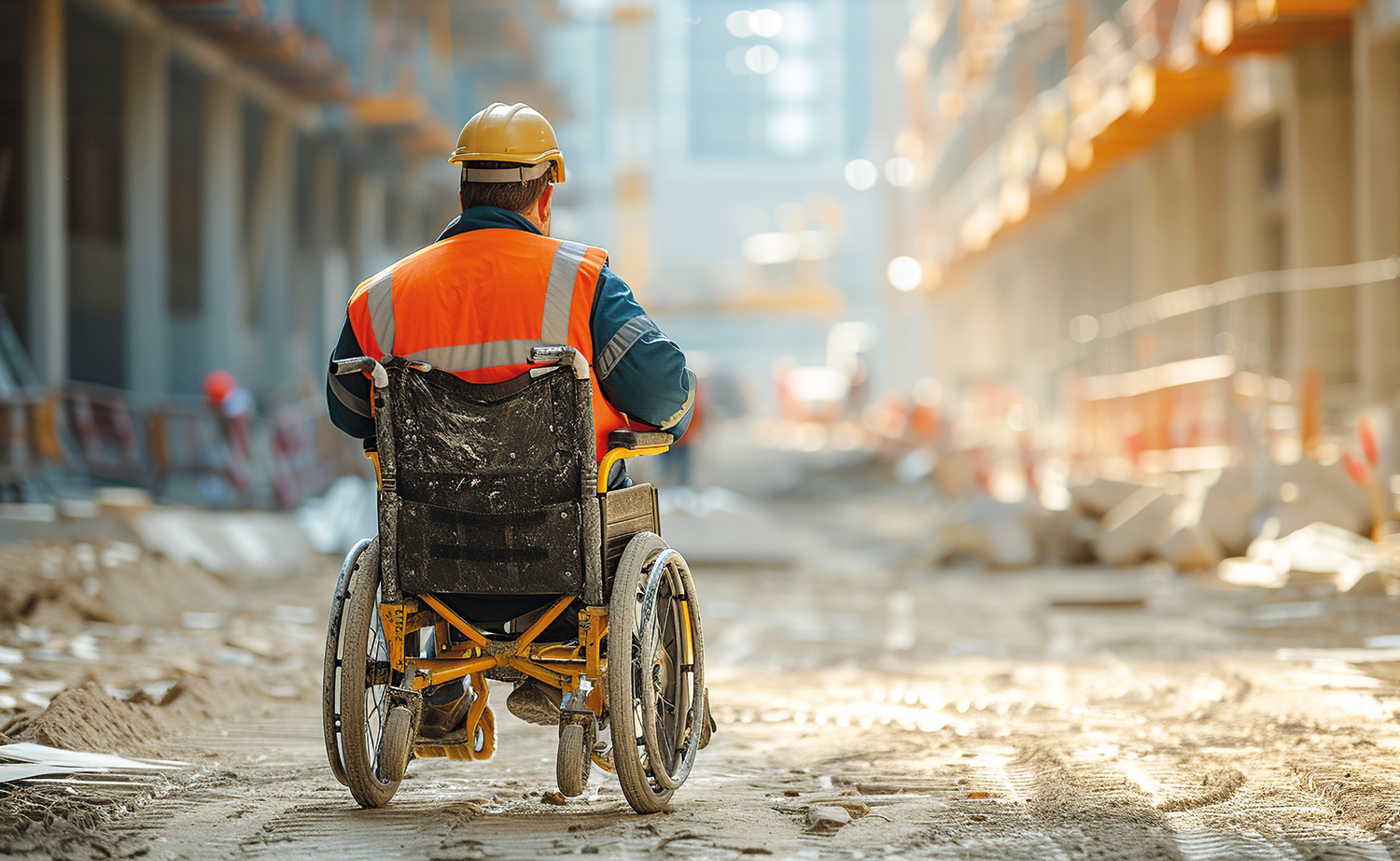
This CPD presents practical initiatives that construction employers can adopt to make their companies more inclusive to disabled workers. By Mark Harrison, Eoin Burns MCIOB and Cristina Lago.
What you will learn in this CPD
- How the law defines disability
- The state of disability in the built environment
- How construction employers can support disabled workers
In the UK, the Equality Act 2010 defines being disabled as having a physical or mental impairment that has a “substantial” and “long-term” negative effect on a person’s ability to carry out normal day-to-day activities.
Under this Act, employers must make “reasonable adjustments” to make sure disabled workers, or those with physical or mental health conditions, are not substantially disadvantaged when doing their jobs.
This statutory definition of disability has attracted criticism for excluding large numbers of people with impairments or ill health who are unlikely to meet the criteria because of the unpredictable characteristics of their condition – we will explore more about the different approaches to disability further down.
However, as it covers a varied range of conditions such as depression, multiple sclerosis, HIV, visual impairment and cancer, around 18% of the working-age population falls within it. Yet, there is a significant under-representation of disabled people in the built environment. In the UK, for example, disabled people make up only around 3% of the sector’s workforce.
Disability in construction
What is perhaps more surprising is that the built environment currently has a significant skills shortage which poses an important challenge to the industry’s economic sustainability. According to the Construction Industry Training Board (CITB), this situation will likely worsen since an estimated 251,500 additional workers will be needed by 2028 if the sector wants to meet its forecasted growth.
It is worth emphasising that construction is a key employer, responsible for 6.5% of jobs in the UK. It not only provides a stable, skilled and fulfilling career for those in the industry, but it also offers relatively better salaries, with average annual earnings £3,000 higher than across all other sectors.
Although the industry has the potential to offer this underrepresented group opportunities to thrive and enjoy a varied career, construction must first make meaningful improvements to recruitment, workplace practices and site accessibility.
If employers want to go beyond the basic provision of ‘reasonable adjustments’ required by the Equality Act, a profound culture change will be needed. This may sound daunting until we consider the radical change the industry has embraced with the adoption of rigorous health and safety measures over recent years.

What is neurodiversity?
Neurodiversity is an umbrella term that describes how people experience and interact with the world differently, and that there is no ‘correct’ way of thinking or behaving. It includes, among others, conditions like autism, ADHD, dyslexia, dyspraxia and Tourette’s syndrome.
While some neurodiverse conditions may be considered disabilities, not all neurodivergent people identify as disabled. However, under the Equality Act 2010, an employee’s neurodiversity could qualify as a disability.
According to the National Federation of Builders, neurodiversity is common in the construction industry, with one in four UK construction workers identifying as neurodivergent.
A survey by the Association for Project Management found that 46% of construction project managers consider themselves neurodivergent, which is higher than the 31% of project managers across all sectors who reported the same.
Research has demonstrated that employing a diverse and representative workforce means companies are more efficient, effective and ultimately more profitable. This is partly because staff who feel valued for their contributions rather than judged on personal characteristics give more discretionary effort – a significant benefit to any company and likely to lead to higher customer satisfaction.
The social model of disability
There are different ways to think about disability which affect how people feel about it. These views are categorised into models that address the causes and responses to disability. Two of the main models of disability are the social model and the medical model.
The social model of disability is an approach which says that people are disabled by barriers in society rather than by a person’s impairment or difference. This model was developed by disabled people as a direct challenge to prevailing models that perceive disability as a medical problem that needs to be ‘cured’. This is the case of the medical model of disability, which considers people are disabled by their impairments or differences.
Under the medical model, these impairments or differences should be ‘fixed’ through medical intervention, even when the impairment or difference does not cause pain or illness.
Conversely, the social model helps identify obstacles that make life harder for disabled people, including physical, structural and cultural barriers. For example, if a disabled person can’t use stairs but there’s a building with a step at the entrance, the social model recognises that this is a problem with the design of the building, not the person, and may suggest adding a ramp.
The barriers identified by the social model can be changed and eliminated, creating equality and giving disabled people more independence, choice and control.
Although most organisations that work with disabled people use the social model of disability, not every disabled person relates to it – how anyone chooses to talk about their impairment is up to them.
Practical steps for employers to support disabled workers:
There are many initiatives that construction employers can implement to make their companies more welcoming and inclusive to disabled workers which go beyond the basic provision of ‘reasonable adjustments’ required by the Equality Act. Here are a few examples:
Obtain funding
Access to Work is a government grant scheme that provides personalised support to disabled people to take up or remain in work.
The funding is available to people who are in paid employment, self-employed, apprentices, trainees, supported interns, doing self-directed work experience, on Jobcentre Plus promoted work trials or going to a job interview. The employer pays for the support and is in turn reimbursed by the Access to Work funding.

Access to Work support is agreed based on individual needs and covers a wide range of interventions beyond ‘reasonable adjustments’ associated with overcoming work-related barriers resulting from disability.
Examples of support provided include a communicator, advocate or British Sign Language (BSL) interpreter for a job interview for a Deaf worker or covering additional costs of taxi fares if a person cannot use public transport to get to work.
Access to Work can support employers to hire disabled people with the skills they need and retain employees who become disabled or develop a health condition.
It also shows that a company values and supports its employees by having good employment policies and practices.
Be a Disability Confident employer
Construction companies can also sign up for the Disability Confident employer scheme, a government initiative that encourages employers to recruit and retain disabled people and those with long-term health conditions.
Disability Confident companies ensure that disabled people have the same opportunities to fulfil their potential as their non-disabled peers.
Useful resources
Many disability organisations in the UK offer online disability guidance and resources for employers.
The Health and Safety Executive has collated useful links at www.hse.gov.uk/disability/resources.htm.
You can find more information on how to apply for Access to Work at www.gov.uk/access-to-work.
Employers can find more guidance to become a Disability Confident employer at www.gov.uk.
The scheme has three certification levels through which employers can progress: level 1 (Disability Confident Committed); level 2 (Disability Confident Employer); and level 3 (Disability Confident Leader). Construction firms that are Disability Confident Leaders include Kier Highways, Laing O’Rourke and the Costain Skanska joint venture for HS2.
Companies that have achieved the highest level must have their self-assessment validated (often by another Disability Confident Leader), confirm they are employing disabled people and report on disability, mental health and wellbeing using the government’s Voluntary Reporting Framework.
Change attitudes
Another step construction employers can take to make their workplaces more inclusive is promoting positive attitudes and policies towards disabled people.
This can include removing obvious barriers like lack of accessible toilets or wheelchair access to buildings to tackling digital barriers that often get overlooked – for example, inaccessible documents and emails or training videos without captions.
Seeking feedback from disabled colleagues about office spaces, policies and processes can help employers address some of the barriers that exist in the workplace.
Research from disability charity Scope found that disabled people experienced negative attitudes from colleagues (41%) and managers (42%). To prevent this, Scope advises giving staff disability awareness training to help them understand the social model of disability and access barriers.
Some workplace habits can exclude disabled people unintentionally – encouraging honest conversations that include disabled employees may help tackle that.
This CPD was produced by Mark Harrison, head of equality, diversity and inclusion transformation at CIOB, Eoin Burns MCIOB, senior proposals manager at Willmott Dixon, and Cristina Lago, deputy editor at Construction Management.
How Willmott Dixon promotes disability awareness

Willmott Dixon became a Disability Confident employer in 2013 and is a member of the Business Disability Forum, a not-for-profit working to remove barriers for disabled employees and customers that offers an advice line and resources on disabilities and medical conditions.
As a signatory of the People Matter Charter, the contractor carries out compulsory but engaging induction training workshops with videos for new employees through the Willmott Dixon University platform to showcase the value of having an inclusive culture at work.
Willmott Dixon also runs a Disability Affinity Group led by Eoin Burns MCIOB, focused on acting as a forum, creating an inclusive and accessible workplace for all staff. In its desire to be more reflective of society, the contractor regularly runs events celebrating inclusion and promoting disability awareness.
For example, during this year’s Deaf Awareness Week in May, Willmott Dixon ran a Lunch and Learn session where employees could join an immersive experience to understand deafness, including the opportunity to learn BSL fingerspelling and basic signs.





